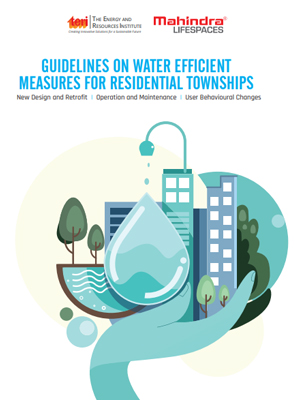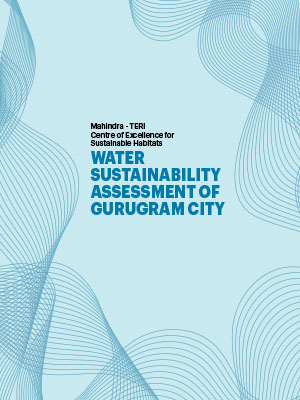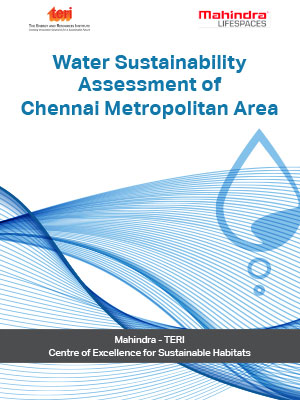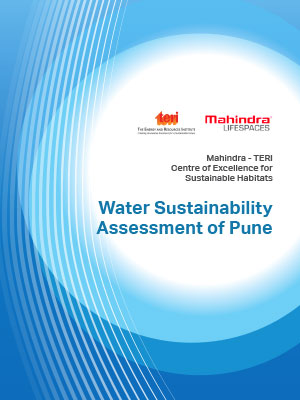Mahindra-TERI Centre of Excellence for Sustainable Habitats
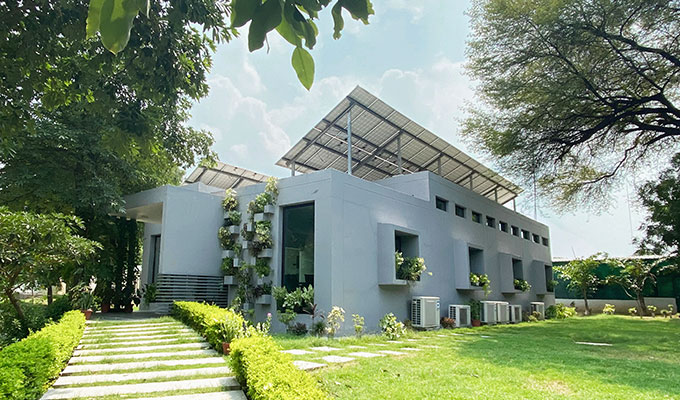
The Center of Excellence aims at developing a robust and coherent database for market-ready, scalable and energy-efficient materials and technologies. It also works towards preparing policy briefs for Central and State Ministries to promote 'green' development that can transform India's housing industry and thereby help reduce the country's carbon footprint. Research output will be validated on the field prior to dissemination of databases, guidelines and standards to the real estate and building materials industry. The research output, which will be available in the public domain, will aim at wider adoption of its recommendations by developers, architects and individual home owners.
The CoE will adopt a tiered approach to implement, review and ensure deliverables. A Technical Advisory Committee (TAC), comprising industry leaders and practitioners, will provide technical oversight to research activities. Located in Gurugram, the CoE is SVA-GRIHA 5-star rated and incorporates various sustainability principles and design strategies espoused by the CoE.
To know more visit website
Guidelines on Water Efficient Measures for Residential Townships
A growing population coupled with rapid urbanization in the metropolitan cities such as Bengaluru, Chennai, Gurugram, Mumbai, Pune and others is leading to an increasing need for accommodation facilities. The need has given rise to a new kind of residential development called townships which are mushrooming at a rapid pace in and around cities. Global change impact on the use of water resources is a reality and recognizing that urbanization such as expansion of residential townships will exert a greater impact on human activity compared to climate change, at least up until 2050, requires urgent action. Therefore, it has become important for residences to use and manage water sustainably.
Since the concept developed in the early 1990s, developers across the country have continuously re-defined the township model as per the market demand. With the emerging Environmental, Social and Governance (ESG) mandate in corporate governance in India, many corporates have embarked on the road to sustainability. Companies have started gradually incorporating SDGs into their responsible business actions, and achieving water self-sufficiency is one of the key action themes. With growing environmental concerns, buyers too are increasingly interested in homes equipped with water-saving technologies.
Sustainable water use in habitats is one of the key areas of research at the Mahindra-TERI Centre of Excellence (CoE), a joint research initiative of Mahindra Lifespaces and The Energy and Resources Institute (TERI), which aims to develop science-based solutions for India’s built environment.
In this context, the Centre of Excellence activity on sustainable water use in habitats was envisioned to look at a holistic way of managing water within a premise for sustained availability for all its consumers.
The study was conducted on two levels of assessment: micro and macro:
- Rapid water audits of residential townships across India (micro level)
- Water sustainability assessment of Chennai, Gurugram and Pune cities (macro level)
Depending on the findings of the study conducted at the micro and macro level, we found out that there was a need for help guides and online tools which could facilitate the user to estimate the water systems related requirements of the site. Today the engagement of all socio-economic segments such as consumers, financiers, managers, developers and corporates has increased. They are now expected to contribute to achieve sustainable water use and management through advanced technology and innovation in their projects. Developers too are re-discovering the township model with growing focus on water conservation and zero wastewater discharge in their projects.
Therefore, deriving from our study, we have developed the ‘Guidelines on Water Efficient Measures for Residential Townships’.
This reference guide adopts a three-point approach framework which focuses on reducing a site’s water usage, harnessing alternative sources of water such as reuse of treated wastewater and rainwater for reducing the dependency on fresh water supplies and integrating green infrastructure for efficient storm water management. It talks about various sustainable design options, technologies, operation and maintenance measures that can be adopted for water-related systems in the township and incorporate best practices by the user for attaining water efficiency.
The measures suggested in the document are innovative, practical and easy to implement. They have been developed after conducting thorough research on national and international case studies and water audits of several townships across India to understand the issues and design solutions.
Water Sustainability Assessment of Gurugram
Report launched on: 28th July, 2021
Authors: Tarishi Kaushik, Akash Deep
The report launch by the Mahindra-TERI Centre of Excellence, and the consequent discussions on water sustainability issues in Gurugram, was held on the occasion of World Nature Conservation Day 2021
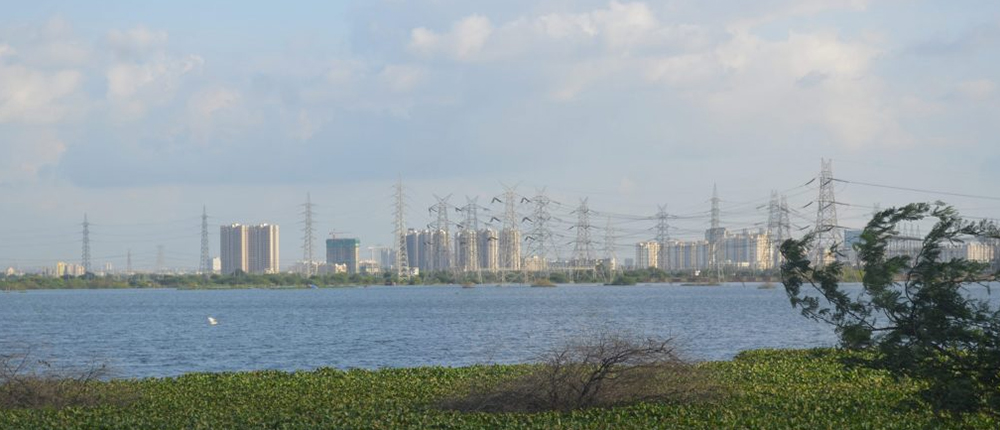
The study analyses various parameters such as city growth, land use, demographics and social & economic character, water policies and institutional setup at central, state and city level, water sources and its related infrastructure. These parameters are essential to find avenues for water sustainability, quantify anthropogenic and natural flows into and out of the town, and develop a metaphorical framework of water metabolism of the area to analyse flows of water within it and selection of dominant indicators that impact urban hydrology. The study of these parameters has led to the identification of potential risks associated with the urban hydrology and management of Gurugram city, especially focusing on the aspects related to the stakeholder engagement and flood risk. To overcome these threats, a list of recommendations has been made. The report also goes a step further to identify the reasons for weak implementation of the proposed recommendations and suggest measures for strengthening it.
The research was conducted by studying the past and existing data on water management, based on which projections for the year 2025 on potential risks were computed. The results/findings of the study are summarized below:
Findings- Gurugram district
S.No. |
Parameters affecting water management | Year 2007 | Year 2017 | Year 2019 | Year 2025 (estimated) |
Potential risks to water sustainability |
| 1. | Land use type - Built Up (in km2) | 189.67 | 358.9 | 393.5 | 518.8 | Increased intensity of floods during monsoons due to reduction in catchment area with shrinking water bodies and green cover because of built up expansion, encroachment and waste disposal. |
| 2. | Land use type - Water Bodies (in km2) | 55.2 | 12.4 | 5.3 | 0.42 | |
| 3. | Land use type - Vegetation (in km2) | 209.6 | 98.9 | 78 | 38.8 |
- Considering the existing urban growth trend in Gurugram district, the built up area is estimated to increase to 518.8 km2 in 2025, almost thrice of what was in 2007. This can be attributed to its emergence as a major industrial hub in the last two decade by doing large-scale acquisition of agricultural lands by the government along with the development of residential townships and infrastructure for multinational companies. Most of the built up expansion is witnessed in the Gurgaon city (tehsil) followed by Manesar tehsil.
- Water bodies will continue to shrink to an alarming 0.42 km2 by 2025 from 55.2 km2 in 2007 due to encroachment by builders, dumping of sewage, silt and construction waste.
Findings- Gurugram city (tehsil)
S.No. |
Parameters affecting water management | Year 2011 | Year 2019 | Year 2025 (estimated) |
Potential risks to water sustainability |
|
Gurugram City |
|||||
| 1. |
Population |
9,77,337 | 23,00,556 | 43,71,939 |
Increased burden on water resources and water supply infrastructure due to rapid rise in population with increased water demand. |
| 2. |
Domestic Water demand (in MLD) |
195.4 | 460.1 | 874.3 | |
| 3. |
Waste water generation (in MLD) |
156.3 | 368 | 699.4 |
Increased discharge of untreated sewage into natural waterways degrading its quality due to inadequate sewage treatment capacities. |
- The region is going to experience an unpredicted pattern of rainfall over the coming years due to rapidly changing climate, thus making it difficult to predict the rainfall intensity and period. This makes it challenging for the authorities to prepare accordingly. The flood intensity during monsoons will keep on increasing in Gurugram city due to reduction in catchment area with shrinking water bodies and green cover and the expansion in built up land and inadequate levels of flood preparedness.
A major factor behind such unpredictable rain spells can be the changing climate across the world due to global warming, of which GHG emissions are the most prominent cause. Earlier, the city used to get continuous light rains over two-three days, spread evenly across monsoon months. But in the last decade, the same quantum of rainfall occurs in just 2-3 hours of irregular downpour even in the monsoon months. These extreme events have been taking place across the entire tropical region for quite some time now.
- Gurugram is going to experience a rapid rise in population by 2025. The population will stand at around 4.3 million with increased water demand at 874.3 MLD.
- The quantity of wastewater generated in Gurugram city is estimated to increase to 699.4 MLD in 2025. The existing installed capacity of STP of 388 MLD would prove insufficient to treat the generated wastewater, thus polluting the natural waterways. It therefore needs to be increased to 734.37 MLD.
Flooding in Gurugram
In the last few years, Gurugram has been bearing the brunt of annual floods disrupting lives and damaging property and infrastructure. The identified reasons for the recurring floods in the Gurugram city are:
- Disrespecting the natural topography: Not taking into account the heterogeneous topography of the region with undulations and natural drainage systems while designing the city's drainage.
- Poor development and planning: Despite the fact that Gurugram is the natural drainage for rainwater from Delhi and nearby areas, buildings and roads on water bodies, natural drains and flood plains were constructed by filling them up with mud.
- Rapid urbanisation and population boom: This unplanned increase in built infrastructure to accommodate rising population has replaced permeable surfaces with impermeable concrete floors.
- Blocked natural drains, encroached water bodies and destruction of traditional water control infrastructure (bundhs): In 1956 Gurugram had around 640 water bodies, which had whittled down to 251 in 2018-19. At least 200 water bodies out of 251 that exist in the city have been encroached.
- Climate Change
What makes this report different?
- The study is carried out using metabolic approach that considers 'One Water', moving away from the age old approach of conducting assessment in isolated entities.
- Integrating both macro and micro level analysis in the assessment of city's water sustainability (water efficiency, conservation and management).
Why makes this this report relevant?
Given the issue of water scarcity which is being faced in the recent years and also the growing realization that the citizens have to contribute for the efforts towards achieving water sustainability, it is expected that this assessment report will help each and every stakeholder who is involved with water sector including citizens to have an understanding of the present and the future challenges and means by which these challenges could be addressed.
Projected Impact
The report envisages the future of the water sustainability in Gurugram and concerns related to it. It is expected that the report will have the following impacts:
- Initiation of a discussion by concerned stakeholders on the potential risks to water sustainability in the Gurugram and development of risk mitigation plans accordingly.
- Developing policies and designing measures towards protecting the region's ecosystems in order to strengthen both the natural and urban water flow system.
- Propagation and adoption of water conservation practices like rainwater harvesting, waste water recycle and reuse etc. in order to meet the rising water demand due to rapid demographic changes.
- Strengthening of the water governance structure and administration by strict rules enforcement, ensuring no overlapping of functions, establishing a transparent and participatory mechanism through capacity building and training programmes.
- Emphasis on development of water efficient infrastructure with new and innovative technologies.
- Enhanced water use efficiency by the end user.
- Designing and implementation of flood resilience measures
Water Sustainability Assessment of Chennai
Report launched on: 5th June, 2021
Authors: Tarishi Kaushik, Akash Deep
The report launch by the Mahindra-TERI Centre of Excellence and the consequent discussions on water sustainability issues in Chennai was held on the occasion of World Environment Day 2021
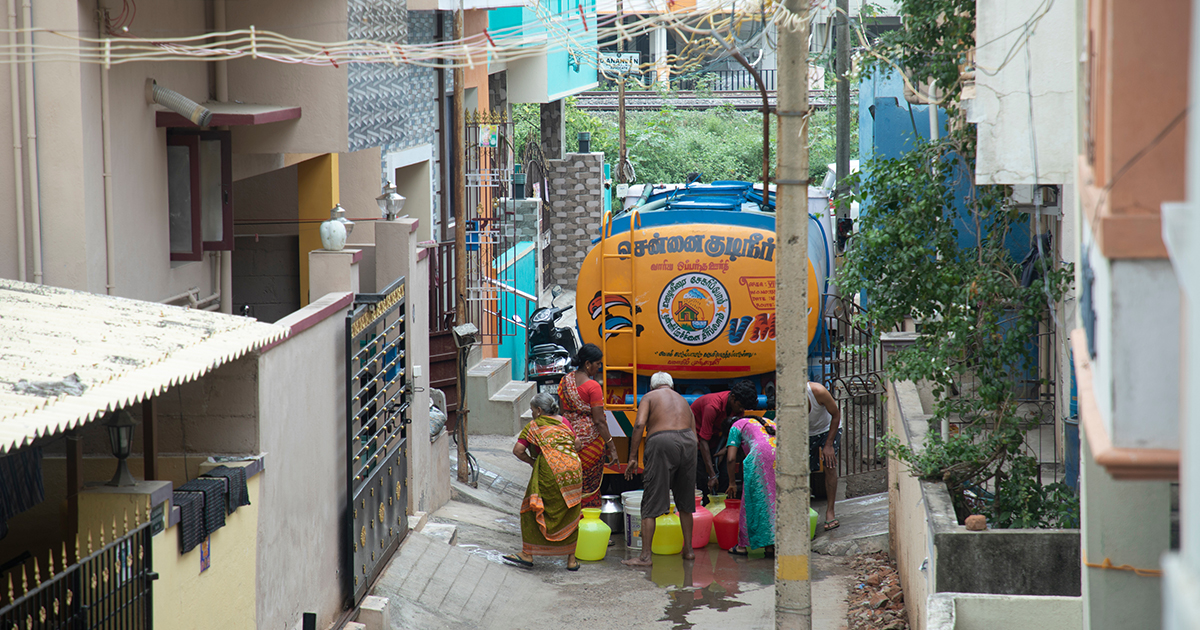
Growing population, expanding economies, increasing urbanisation, and changing lifestyles have had a major impact on our economic, social, and environmental wellbeing. An important impact among these has been increased pressure on already strained water resources. Rapid population growth and rising consumption and pollution levels, are contributing to increasing water insecurities in urban India. The simultaneous depletion of water resources and rising demand leave limited possibilities to augment water supply for the future. Further, more pronounced effects of climate change such as increased magnitude and frequency of extreme weather events and altered precipitation volume and pattern shall also have adverse effects on the available sources of fresh water supply.
In the summer of 2019, multiple reservoirs in Chennai ran dry, resulting in rows of empty pots dotting the pavements and people lining up for supplies from water tankers. For a city that gets an average of 1,400 mm of rainfall a year and had suffered heavy floods just four years ago in 2015, this was unprecedented.
Cities in India have been experience increased water woes over the years. Water stress has specifically deepened in cities like Chennai, Gurugram, Pune, Delhi etc. with depleting groundwater levels, widening gap between water demand and supply, and rising pollution of water bodies, to name a few issues. In order to combat these issues, there is a need to enhance sustainable water flow and management in cities.
It is in this background that the Mahindra-TERI Centre of Excellence (MTCoE) carried out a study to assess water sustainability in Chennai, Gurugram, and Pune. This report is based on the water sustainability assessment of Chennai Metropolitan Area (CMA), with the study identifying potential risks associated with water sources, governance, infrastructure, and demand and supply, and recommendations to mitigate the same. The report pictures the future of water sustainability in CMA and the concerns related to it.
MTCoE is a joint research initiative of Mahindra Lifespaces (MLDL) and TERI, which aims to develop science-based solutions for India's future built environment, with a view to reduce the energy footprint of the real estate industry. Sustainable water use in habitats is one of the research activities being carried out. This includes both macro and micro level analysis in terms of water efficiency, conservation, and management within a premise by end users.
For the study, a desk-based research was carried out by exploring different types of literature. A number of official reports and documents, Acts etc. by the state government (Tamil Nadu), urban local bodies, municipalities and other concerned institutions, including research by private organisations, were studied.
The study has analysed various parameters i.e. city growth, land use, demographics and social and economic character, water policies and institutional setup at central, state and city level, water sources and its related infrastructure, that are essential to find avenues for water sustainability, quantify anthropogenic and natural flows into and out of the area, and develop a metaphorical framework of water metabolism of the area to analyse flows of water within it and selection of dominant indicators that impact urban hydrology.
The study of these parameters has led to the identification of potential risks associated with the CMA's urban hydrology and its management. To overcome these threats, there are a list of recommendations. The report also goes a step further to identify the reasons for the weak implementation of the proposed recommendations and suggest measures for strengthening it.
The research includes a study of the past and present data on water management based on which projections for the year 2025 on potential risks have been computed. The results of the study are summarised below:
Chennai Metropolitan Area
| S.No. | Parameters affecting water management | Year 2011 | Year 2019 | Year 2025 (estimated) | Potential risks to water sustainability |
| 1 | Land use type - Built Up (in km2) | 374.3 (year 1997) | 608.3 | 708.3 | Increased intensity of floods during monsoons due to reduction in catchment area with shrinking water bodies and green cover because of expansion of built-up area, encroachment, and waste disposal. |
| 2 | Land use type - Water Bodies (in km2) | 117 (year 1997) | 50.7 | 38.4 | |
| 3 | Population (in lakhs) | 86,53,521 | 1,03,72,643 | 1,18,82,610 | Increased burden on water resources and water supply infrastructure due to rapid rise in population with increased water demand. |
| 4 | Domestic water demand (in MLD) | 1,730 | 2,074 | 2,236.5 | |
| 5 | Waste water generation (in MLD) | 1,384 | 1,659 | 1,789.2 | Increased discharge of untreated sewage into natural waterways, degrading their quality due to inadequate sewage treatment capacities. |
| 6 | Sewage treatment plant capacity (in MLD) | 558 | 727 | 1878.6 |
- Considering the existing urban growth trend in Chennai City, the built-up area is estimated to increase to 708.3 km2 in 2025 from 608.3 km2 in 2019, thrice of what was in 1997 and water bodies will continue to shrink to 38.4 km2 by 2025 in comparison to 50.7 km2 in 2019, three times less than the year 1997.
- The region is going to experience an unpredictable pattern of rainfall over the coming years due to rapidly changing climate, extreme El Nino conditions, and continuous warming of the Bay of Bengal off the Tamil Nadu coast, thus making it difficult to predict the rainfall intensity and period, making it challenging for the authorities to be prepare accordingly. This could also lead to the water storage capacity in the reservoirs fluctuating throughout the year. This increasing risk of flooding in the CMA can be further attributed to years of illegal development and inadequate levels of flood preparedness.
- Chennai is going to experience a rapid rise in population. By 2025 the population will stand at around 8 million with increased water demand at 2,236.5 MLD, requiring augmentation of the capacity of water treatment plants from 1,294 MLD (as of 2019) to 2,348.3 MLD.
- The quantity of wastewater generated in Chennai City is estimated to increase to 1,789.2 MLD in 2025. The existing installed capacity of STP of 727 MLD would prove insufficient to treat the wastewater generated, thus polluting the natural water ways. This capacity, therefore, needs to be increased to 6 MLD.
The study also highlights the concerns related to unavailability of updated groundwater data, thus leading to inefficient regulation of groundwater use by the administration, resulting in continuous exploitation.
The study integrates both macro and micro level (water audits of residential townships in CMA) analysis in this assessment, which shows the prevalence of unsustainable water use pattern by the end user, resulting in increased water wastage.
In order to combat these rising urban water issues, there is a need to enhance sustainable water flow and management in cities. The key recommendations suggested for sustainable water management based on the identified potential risks are summarised here:
- Robust stakeholder engagement with discussion on the potential risks to water sustainability in Chennai City and develop risk mitigation plans accordingly.
- Developing policies and designing measures towards protecting the region's ecosystems in order to strengthen both the natural and urban water flow system.
- Propagation and adoption of water conservation practises such as rainwater harvesting, wastewater recycling and reuse etc. in order to meet the rising water demand due to rapid demographic changes.
- Strengthening of the water governance structure and administration by strict enforcement of rules, ensuring no overlapping of functions, and establishing a transparent and participatory mechanism through capacity building and training programmes.
- Identification and filling up of data gaps related to groundwater availability, extraction and use by conducting detailed surveys.
- Emphasis on the development of water-efficient infrastructure with new and innovative technologies.
- Enhanced water use efficiency by the end-user.
More such studies should be conducted for various cities in the country that are facing water stress, using an approach that integrates all the aspects such as source management and water/wastewater/storm water infrastructure etc., like the one followed in this study. This shall provide a holistic view of the water scenario and the inter connectedness of these aspects, thus helping design effective and implementable solutions.
Water Sustainability Assessment of Pune
Authors: Tarishi Kaushik, Akash Deep
According to The World Bank, urban population in India was estimated to be 34.5% in the year 20191. There has been an increase in urbanization by almost 4% in the last decade due to growing migration of people from rural areas to cities in search of better job opportunities. It is estimated that at this rate by year 2030 and further in 2050, population of people living in Indian cities will go beyond 40% and 50% respectively2.
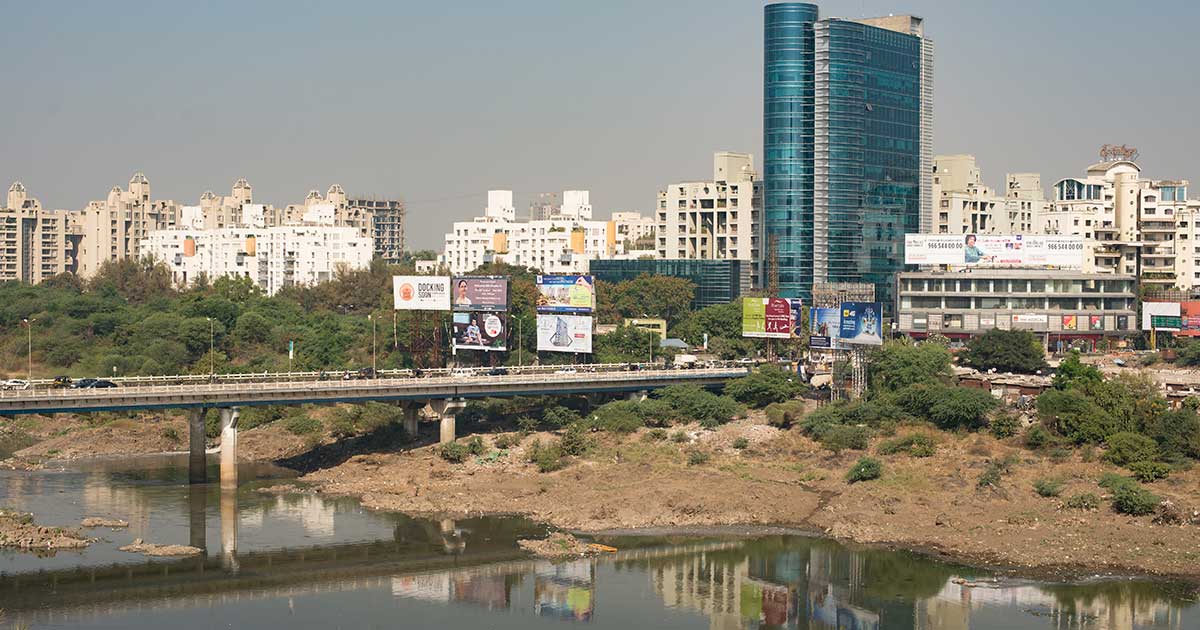
With a growing population, expanding economies, urbanization, and changing lifestyles this has had a major impact on our economic, social and environmental wellbeing due to increasing pressure on already strained water resources. The rapid population growth along with rising consumption levels and pollution is contributing in increasing water insecurities in urban India. The depleting water resources on the one hand, rising water demand on the other, leave limited possibilities to augment the water supply in the coming future. Rising effects of climate change may further aggravate the situation by generating higher magnitude and frequency of extreme weather events and also by altering the precipitation volume & pattern, which shall have adverse effects on the available sources of fresh water supply.
Water stress has specifically magnified for metropolitan cities like Chennai, Delhi, Pune, etc. with depleting groundwater levels, widening of water demand and supply gap and rising pollution of water bodies to name a few.
In this context, Mahindra-TERI Centre of Excellence (MTCoE) carried out a study to assess the water sustainability in the cities of Chennai, Gurugram and Pune. This report shows the water sustainability assessment of Pune and Pimpri Chinchwad cities, with study identifying potential risks associated with water sources, governance, infrastructure and demand & supply and provide recommendations to combat those risks.
MTCoE is a joint research initiative of Mahindra Lifespaces (MLDL) and TERI, which aims to develop science-based solutions for India's future built environment, with a view to reduce the energy footprint of the real estate industry. Sustainable water use in habitats is one of the research activities being carrying out which includes both macro and micro level analysis in terms of water efficiency, conservation and management within a premise by end users.
The research was conducted by studying the past and existing data on water management, based on which projections for the year 2025 on potential risks were computed. The results of the study are summarized as follow:
| S.No. | Parameters affecting water management | Year 2011 | Year 2019 | Year 2025 | Potential risks to water sustainability |
| Pune City (PMC area) | |||||
| 1 | Land use type - Built Up (in km2) | 155.9 | 182.55 | 205.49 | Increased intensity of floods during monsoons due to reduction in catchment area with shrinking water bodies and green cover because of built up expansion, encroachment and waste disposal. |
| 2 | Land use type - Water Bodies (in km2) | 4.1 | 4.02 | 3.97 | |
| 3 | Population (in lakhs) |
31,24,458 | 37,29,117 | 42,67,485 | Increased burden on water resources and water supply infrastructure due to rapid rise in population with increased water demand. |
| 4 | Domestic water demand (in MLD) | 605 | 745.8 | 853.5 | |
| 5 | Waste water generation (in MLD) |
586 | 596.6 | 682.8 | Increased discharge of untreated sewage into natural waterways degrading its quality due to inadequate sewage treatment capacities. |
| 6 | Sewage treatment plant capacity (in MLD) | 527 | 567 | 567 | |
| Pimpri Chinchwad City (PCMC area) | |||||
| 1 | Land use type - Built Up (in km2) | 91.42 | 138 | 187.94 | Increased intensity of floods during monsoons due to reduction in catchment area with shrinking water bodies and green cover because of built up expansion, encroachment and waste disposal. |
| 2 | Land use type - Water Bodies (in km2) | 3.18 | 2.99 | 2.86 | |
| 3 | Population (in lakhs) |
17,29,359 | 26,59,149 | 34,97,819 | Increased burden on water resources and water supply infrastructure due to rapid rise in population with increased water demand. |
| 4 | Domestic Water demand (in MLD) | 294 | 439 | 577 | |
| 5 | Waste water generation (in MLD) | 296 | 351.2 | 461.6 | Increased discharge of untreated sewage into natural waterways degrading its quality due to inadequate sewage treatment capacities. |
| 6 | Sewage treatment plant capacity (in MLD) | 261 | 317 | 317 | |
In addition to this, the region is expected to experience an unpredictable rainfall pattern over the coming years due to rapidly changing climate, thus adding up to the rising flood risk. This would also result in fluctuating water storage levels in the reservoirs, thus widening the water demand & supply gap due to decreased water availability from natural water resources during dry months.
The study also highlights the concern related to unavailability of updated groundwater data thus leading to inefficient regulation of groundwater use by the administration, resulting in continuous exploitation.
The study integrates both macro and micro level (water audits of residential townships in Pimpri Chinchwad) analysis in this assessment, which shows the prevalence of unsustainable water use pattern by the end user, resulting in increased water wastage.
And therefore in order to combat these rising urban water issues, there is a need to enhance the sustainable water flow and management in cities. The key recommendations suggested for sustainable water management based on the identified potential risks are summarised here:
| S.No. | Domain | Recommendations |
| 1 | Environment |
|
| 2 | Socio-Demographic |
|
| 3 | Governance |
|
| 4 | Infrastructure |
|
| 5 | Consumption pattern |
|
More such studies for various cities across the country should be conducted facing water stress conditions, using the approach which integrates all the aspects such as source management, water/wastewater/storm water infrastructure etc., like the one followed in the study of this report.
The report envisages the future of the water sustainability in Pune and concerns related to it. It is expected that the report will have the following impacts:
- Initiation of the discussion by the concerned stakeholders on the potential risks to water sustainability in the cities of Pune and Pimpri Chinchwad and develop the risk mitigation plans accordingly.
- Developing policies and designing measures towards protecting the regions ecosystems in order to strengthen both the natural and urban water flow system.
- Propagation and adoption of water conservation practises like rainwater harvesting, waste water recycle and reuse etc. in order to meet the rising water demand due to rapid demographic changes.
- Strengthening of the water governance structure and administration by strict rules enforcement, ensuring no overlapping of functions, establishing a transparent and participatory mechanism through capacity building and training programmes.
- Emphasis on development of water efficient infrastructure with new and innovative technologies.
- Enhanced water use efficiency by the end user.
Footnotes:
[1] https://data.worldbank.org/indicator/SP.URB.TOTL.IN.ZS?end=2019&locations=IN&start=1960
[2] https://www.thestatesman.com/business/urban-population-india-may-go-beyond-50-2050-mohua-secretary-1502757868.html

